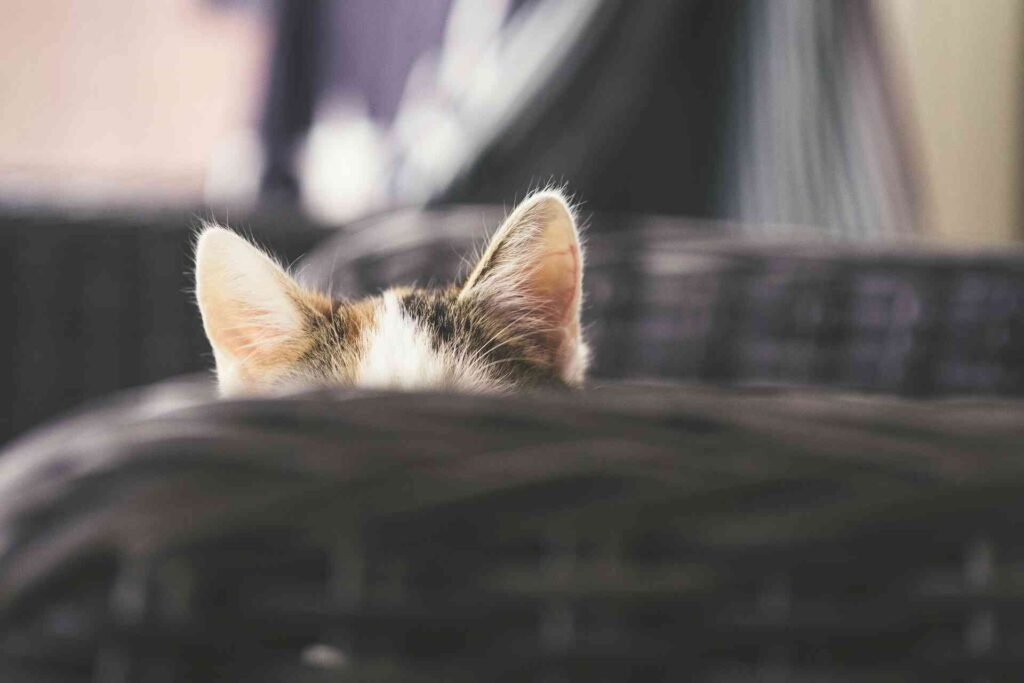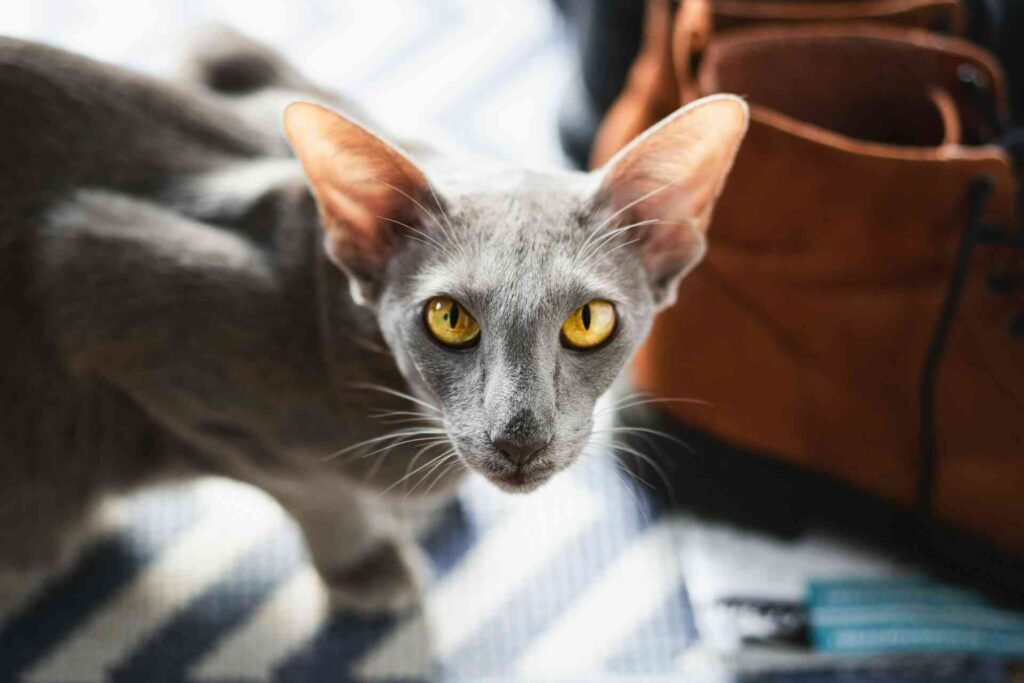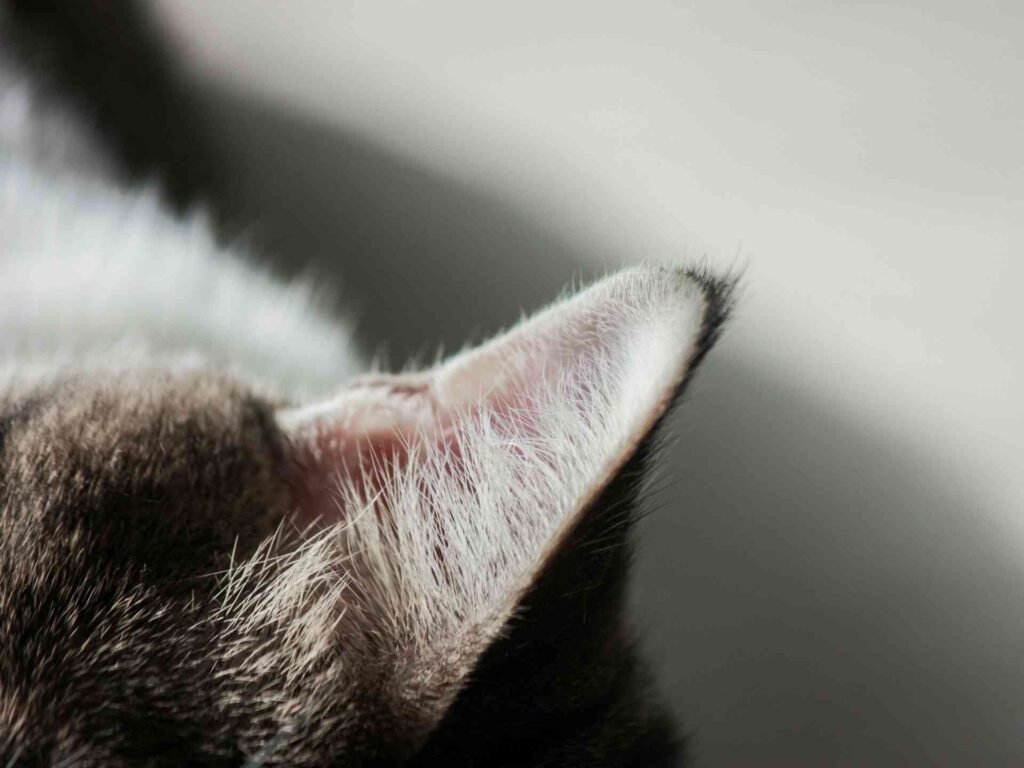Have you ever gazed at your feline friend and wondered: why do cats have pointy ears? Those triangular, alert appendages aren’t just adorable, they’re sophisticated biological tools that have evolved over thousands of years. From domestic cats with pointy ears lounging on your sofa to wild felines stalking prey in the savanna, these distinctive ear shapes serve vital purposes that have helped cats become the successful predators and beloved companions they are today.

The Evolutionary Purpose Behind Cats’ Pointed Ears
When we admire our domestic cat with pointy ears, we’re actually looking at an evolutionary masterpiece. Cat ears have developed their distinctive pointed shape through natural selection, optimizing several critical functions that enhance a cat’s survival abilities.
The pointy structure of feline ears isn’t random, it represents thousands of years of evolutionary refinement. Wild ancestors of our house cats relied heavily on their hearing to detect prey and avoid predators. The pointed shape allows for better sound collection and directional hearing, giving cats a significant advantage in their natural environments.
Even today, our domestic cats retain these specialized features. The next time you see your cat’s ears twitching and rotating toward a sound, you’re witnessing the same evolutionary adaptations that helped their ancestors survive in the wild.
Why Are Cats’ Ears Pointy? The Science of Sound Collection
The question “why are cats’ ears pointy?” has a fascinating scientific answer related to acoustics. The pointed shape creates an effective funnel for sound waves, directing them toward the ear canal with remarkable precision.
Unlike human ears, cat ears can independently rotate up to 180 degrees, with each ear containing 32 muscles (compared to our mere 6). This remarkable mobility combines with the pointed shape to create a highly efficient sound-gathering system. Their triangular shape helps amplify sounds and pinpoint their origin with incredible accuracy.
This acoustic advantage explains why cats often detect sounds long before we do. The sharp, pointed design of their ears allows them to hear frequencies up to 64 kHz, well beyond our human limit of about 20 kHz. So when your cat suddenly perks up those pointy ears toward seemingly nothing, they’re likely responding to sounds completely imperceptible to you.
Cat Pointy Ears: Communication and Expression
Those sharp ears aren’t just for hearing, they’re also sophisticated communication tools. When observing cat pointy ears meaning in body language, you’ll notice how they use these mobile appendages to express a wide range of emotions.
Forward-facing, upright pointy ears typically indicate an alert, interested cat. When those same pointed ears flatten against the head, your cat is signaling fear or aggression. Slight movements in different directions can communicate everything from playfulness to irritation.
The pointed shape enhances these visual signals, making them more noticeable to other animals. In multi-cat households, these ear positions serve as important social cues that help maintain harmony and establish boundaries between feline housemates. For more insights into how cats communicate through body positioning, our article on Cat Sleeping Positions explores how even during rest, cats express themselves through physical cues.
Why Do House Cats Have Pointy Ears? Adaptation to Domestic Life
Domestic cats have retained their pointed ears despite thousands of years of living alongside humans. Why do house cats have pointy ears when they no longer need to hunt for survival? The answer lies in the relatively recent timeline of cat domestication.
Compared to dogs, cats have undergone far less selective breeding to modify their natural characteristics. Most domestic cats with pointy ears still closely resemble their wild ancestors anatomically, retaining many of the same instincts and physical attributes, including those distinctive pointed ears.
Even in the comfort of our homes, cats benefit from their superior hearing abilities. Modern house cats use their pointed ears to track the movements of toys, detect potential threats (like the dreaded vacuum cleaner), and monitor human activity throughout the home. The triangular shape remains as useful in domestic settings as it was in the wild.
What Cats Have Pointy Ears? Breeds and Variations
While nearly all cats have somewhat pointed ears, some breeds showcase particularly pronounced triangular shapes. If you’re wondering what cats have pointy ears that stand out from the rest, several distinctive breeds come to mind:
| Breed | Ear Characteristics | Notable Features |
|---|---|---|
| Abyssinian | Medium-sized, wide at base with rounded tips | Alert appearance with distinctive red/ruddy coat |
| Oriental Shorthair | Extremely large and pointed | Bat-like appearance, stands out from the head |
| Siamese | Large, pointed, wide at base | Continues the triangular shape of the face |
| Cornish Rex | Large, high-set pointed ears | Complements their unusual curly coat |
| Devon Rex | Oversized, low-set pointy ears | Gives an elf-like appearance |
| Egyptian Mau | Medium-sized alert pointy ears | Works with their spotted coat for a wild look |

While selective breeding has enhanced the pointed characteristics in some breeds, the fundamental structure remains consistent across domestic cats. The degree of “pointiness” varies, but the functional design principles remain intact across breeds. For a comprehensive look at how physical characteristics vary among cats, our article on Cat Fur Patterns and Types offers insights into how coat variations complement ear shapes across different breeds.
Why Do Some Cats Have Pointy Ears That Are Different?
You might notice variations in ear shape among different cats and wonder why do some cats have pointy ears that look different from others. Several factors influence these differences:
Genetic Factors: Breeding selections over generations have enhanced certain ear characteristics in specific breeds.
Age-Related Changes: Kittens are born with smaller, rounder ears that become more pointed as they mature.
Individual Variations: Even within the same breed, cats can display unique ear shapes and positions.
Health Considerations: Certain conditions can affect ear carriage and appearance, sometimes making ears appear less pointed.
Temperature Regulation: Cats in colder climates may have slightly smaller ears to reduce heat loss, while desert-dwelling cats might have larger ears that help dissipate heat.
These variations showcase the remarkable adaptability of feline physiology while maintaining the core functional benefits of the pointed ear design.
Beyond Hearing: The Multifunctional Nature of Cat Ears
The sharp, triangular shape of cat ears serves purposes beyond sound collection. These specialized structures also help with:
Temperature Regulation: The thin skin and abundant blood vessels in cat ears help regulate body temperature by expanding or contracting to release or conserve heat.
Balance: The inner ear structures work in conjunction with the external ear to help cats maintain their famous balance and coordination.
Protection: The pointed shape, combined with the ability to flatten against the head, helps protect the sensitive ear canal during conflicts or when navigating tight spaces.
Emotion Indication: As we’ve explored, cat with pointy ears can express a wide range of emotions through subtle positioning changes, helping them communicate with humans and other animals.
This multifunctionality demonstrates why the pointed ear design has remained so consistent throughout feline evolution, benefiting cats in numerous ways beyond just improved hearing.
Caring for Your Cat’s Pointed Ears
Those distinctive pointed ears require proper care to maintain their health and functionality. Here are some tips for keeping your cat with sharp ears in top condition:
Regular Inspection: Check your cat’s ears weekly for signs of dirt, wax buildup, or inflammation.
Gentle Cleaning: When necessary, use a veterinarian-recommended ear cleaner and soft cloth to carefully clean the outer ear area.
Parasite Prevention: Keep up with parasite prevention to protect against ear mites, which can cause intense irritation and potential damage.
Environmental Awareness: Remember that cats with pointed ears are sensitive to loud noises due to their exceptional hearing abilities. Create quiet spaces where they can retreat when needed.
Temperature Considerations: Outdoor cats with pointy ears may be susceptible to frostbite in extremely cold weather. Provide warm shelter during winter months.

By understanding and properly caring for your cat’s unique ear structure, you’ll help ensure these remarkable organs continue functioning optimally throughout your pet’s life.
Frequently Asked Questions About Cat Ears
Can cats move their ears independently?
Yes, cats can move each ear independently of the other, giving them remarkable directional hearing abilities. Each ear can rotate up to 180 degrees, allowing cats to pinpoint sounds with extraordinary precision without moving their heads.
Do all cat breeds have equally pointy ears?
While most cats have somewhat pointed ears, the degree of “pointiness” varies between breeds. Some breeds like the Oriental Shorthair and Abyssinian have particularly pronounced pointed ears, while others like Scottish Folds have distinctive folded ears due to a genetic mutation.
How does a cat’s hearing compare to human hearing?
Cats have significantly superior hearing to humans. They can detect sounds up to 64 kHz (compared to humans’ 20 kHz limit) and can hear sounds from much greater distances. Their pointed ears contribute substantially to this enhanced hearing ability.
Why do cats sometimes flatten their ears against their head?
When cats flatten their pointy ears against their head, they’re usually expressing fear, anxiety, or aggression. This positioning also serves a protective function, keeping the sensitive ears safe during potential conflicts.
Can cats hear better than dogs?
While both cats and dogs have excellent hearing compared to humans, cats generally have a slight edge, especially at higher frequencies. Cats can hear up to 64 kHz, whereas most dogs hear up to about 45 kHz. The distinctive pointed shape of cat ears contributes to this superior hearing ability.
Why Cats Have Sharp Ears: Putting It All Together
The question “why do cats have sharp ears?” has multiple answers that showcase the remarkable evolutionary design of our feline friends. These pointed appendages represent a perfect marriage of form and function, serving critical roles in:
- Sound collection and directional hearing
- Effective communication with other animals and humans
- Temperature regulation
- Protection of sensitive inner ear structures
- Emotional expression
- Balance and coordination
The triangular, pointed shape we find so distinctive and charming is actually a sophisticated biological tool that has contributed significantly to cats’ success as a species. Whether you’re admiring a domestic cat with pointy ears curled up on your sofa or watching a wild feline utilizing these same structures to hunt prey, the fundamental design principles remain remarkably consistent.
As we continue to appreciate and understand more about feline anatomy and behavior, the pointed ears of our cats stand as a testament to nature’s elegant solutions to evolutionary challenges. These seemingly simple structures actually represent complex adaptations that continue to serve cats well in both wild and domestic settings.
Looking for more? Explore our Cat Health section for more posts like this, visit the Blog for fun and insightful reads, or browse our full Cat Category for everything feline-related, from care to comfort.
Disclaimer: This article is for informational purposes only and does not substitute for professional veterinary advice. Always consult your veterinarian for diagnosis and treatment tailored to your cat’s individual needs. Please verify current product information directly on the retailer’s site before purchasing.
References
- Peake, W. T. & Peake, H. C. (2004). INTERSPECIES VARIATION IN CAT-FAMILY MIDDLE EARS. Middle Ear Mechanics in Research and Otology, pp. 11-18. https://doi.org/10.1142/9789812703019_0002
- Populin, Luis & Yin, Tom. (1998). Pinna Movements of the Cat during Sound Localization. The Journal of neuroscience : the official journal of the Society for Neuroscience. 18. http://dx.doi.org/10.1523/JNEUROSCI.18-11-04233.1998
- Ryugo, David & Menotti-Raymond, Marilyn. (2012). Feline Deafness. The Veterinary clinics of North America. Small animal practice. 42. 1179-207. http://dx.doi.org/10.1016/j.cvsm.2012.08.008
Check out our most recent articles!
- Cats and Snow: Why Some Love It and Others Don’tSnow isn’t just uncomfortable for many cats, it’s a complete sensory overload. From cold paw pads to wet fur and changed landscapes, winter challenges feline comfort in unexpected ways. Learn how to recognize stress signals and create cozy alternatives for snow-averse cats.
- Christmas Names for Cats: From Classic to Creative Holiday IdeasNaming your holiday cat goes beyond festive fun. Discover why Christmas-inspired names age beautifully, spark instant connections with fellow pet lovers, and capture the warmth cats bring to our homes during the most magical season of the year.
- How to Keep Your Cat From Drinking Christmas Tree WaterYour cat’s obsession with Christmas tree water isn’t just annoying, it’s genuinely dangerous. From harmful bacteria to toxic additives, that festive reservoir poses real health risks. Discover practical solutions that protect your pet without sacrificing holiday cheer.
- Best Cat Toys for Christmas: The Ultimate Guide to Holiday JoyNot all Christmas gifts end up under the tree, some get batted across the floor at 3 AM. Explore the wonderful world of holiday cat toys that match your feline’s personality, from plush companions for cuddlers to high-tech options for the eternally energetic.
- Are Fake Christmas Trees Safe for Cats? A Holiday Safety GuideThat beautiful Christmas tree might look festive to you, but to your cat, it’s an irresistible climbing gym with built-in toys. Find out whether artificial trees are truly safer for cats and discover the hidden dangers lurking in your holiday decorations.
- The Best Christmas Gifts for Cats That’ll Actually Get Used (Not Ignored)Not all Christmas gifts land on the nice list with our feline friends. Discover which presents actually spark joy in cats and which ones end up gathering dust under the couch by New Year’s Day.
- Do Cats Eat Less in Winter? How Cold Weather Affects Your Cat’s AppetiteWinter brings more than just cold weather, it can completely change your cat’s eating habits. From bored indoor cats to outdoor ferals fighting to survive, discover what’s really driving those appetite changes and how to respond appropriately.
- Are Humidifiers Good for Cats? A Complete Safety & Health GuideNot all humidifiers are cat-safe, and some common practices could be toxic. Learn why cool mist beats warm mist, why essential oils are dangerous for felines, and how proper humidity levels between 30-50% support your cat’s breathing and coat health.
- How to Protect Leather Furniture From Cats (Without Losing Your Mind)Leather furniture and cat claws seem like natural enemies, but they don’t have to be. Learn why your cat is drawn to that expensive couch in the first place, and how simple redirects can save your furniture while keeping your cat’s natural behaviors satisfied.
- The Best Material for Cat Bowls: Protect Your Cat from BacteriaStainless steel, ceramic, or plastic, which material keeps your cat healthiest? We break down the science behind cat bowl materials, revealing why some harbor bacteria and others last decades without compromising your feline’s wellbeing.










